Paper-Based Analytical Device for One-Step Detection of Bisphenol-A Using Functionalized Chitosan
Abstract
1. Introduction
2. Experimental
2.1. Reagents and Materials
2.2. Fabrication of Chitosan-PAD
2.3. Characterization
2.4. Detection of BPA Using Chitosan-PAD
2.5. Selectivity Study
2.6. Pre-Concentration Study
3. Results
3.1. Chitosan-PAD Preparation
3.2. FTIR Characterization
3.3. Method Optimization
3.4. Detection by Smartphone
3.5. Calibration Curve
3.6. Pre-Concentration Study
3.7. Selectivity Study
3.8. Stability Study
3.9. Advantages and Versatility of the Proposed Strategy
3.10. Real Sample
4. Conclusions
Author Contributions
Funding
Institutional Review Board Statement
Informed Consent Statement
Data Availability Statement
Conflicts of Interest
References
- Geens, T.; Aerts, D.; Berthot, C.; Bourguignon, J.-P.; Goeyens, L.; Lecomte, P.; Maghuin-Rogister, G.; Pironnet, A.-M.; Pussemier, L.; Scippo, M.-L.; et al. A Review of Dietary and Non-Dietary Exposure to Bisphenol-A. Food Chem. Toxicol. 2012, 50, 3725–3740. [Google Scholar] [CrossRef]
- Vilarinho, F.; Sendón, R.; van der Kellen, A.; Vaz, M.F.; Silva, A.S. Bisphenol A in Food as a Result of Its Migration from Food Packaging. Trends Food Sci. Technol. 2019, 91, 33–65. [Google Scholar] [CrossRef]
- Fisher, M.; Arbuckle, T.E.; MacPherson, S.; Braun, J.M.; Feeley, M.; Gaudreau, É. Phthalate and BPA Exposure in Women and Newborns through Personal Care Product Use and Food Packaging. Environ. Sci. Technol. 2019, 53, 10813–10826. [Google Scholar] [CrossRef]
- Ema, M.; Fujii, S.; Furukawa, M.; Kiguchi, M.; Ikka, T.; Harazono, A. Rat Two-Generation Reproductive Toxicity Study of Bisphenol A. Reprod. Toxicol. 2001, 15, 505–523. [Google Scholar] [CrossRef]
- Dallio, M.; Diano, N.; Masarone, M.; Gravina, A.G.; Patanè, V.; Romeo, M.; Di Sarno, R.; Errico, S.; Nicolucci, C.; Abenavoli, L.; et al. Chemical Effect of Bisphenol A on Non-Alcoholic Fatty Liver Disease. Int. J. Environ. Res. Public Health 2019, 16, 3134. [Google Scholar] [CrossRef]
- Kobroob, A.; Peerapanyasut, W.; Chattipakorn, N.; Wongmekiat, O. Damaging Effects of Bisphenol A on the Kidney and the Protection by Melatonin: Emerging Evidences from In Vivo and In Vitro Studies. Oxidative Med. Cell. Longev. 2018, 2018, 3082438. [Google Scholar] [CrossRef]
- Özaydın, T.; Öznurlu, Y.; Sur, E.; Çelik, İ.; Uluışık, D. The Effects of Bisphenol A on Some Plasma Cytokine Levels and Distribution of CD8+ and CD4+ T Lymphocytes in Spleen, Ileal Peyer’s Patch and Bronchus Associated Lymphoid Tissue in Rats. Acta Histochem. 2018, 120, 728–733. [Google Scholar] [CrossRef]
- Olukole, S.G.; Lanipekun, D.O.; Ola-Davies, E.O.; Oke, B.O. Melatonin Attenuates Bisphenol A-Induced Toxicity of the Adrenal Gland of Wistar Rats. Environ. Sci. Pollut. Res. 2019, 26, 5971–5982. [Google Scholar] [CrossRef]
- Patisaul, H.B. Achieving CLARITY on Bisphenol A, Brain and Behaviour. J. Neuroendocr. 2020, 32, e12730. [Google Scholar] [CrossRef]
- Peyre, L.; Rouimi, P.; de Sousa, G.; Héliès-Toussaint, C.; Carré, B.; Barcellini, S.; Chagnon, M.-C.; Rahmani, R. Comparative Study of Bisphenol A and Its Analogue Bisphenol S on Human Hepatic Cells: A Focus on Their Potential Involvement in Nonalcoholic Fatty Liver Disease. Food Chem. Toxicol. 2014, 70, 9–18. [Google Scholar] [CrossRef]
- Silva, J.P.A.; Ramos, J.G.; Campos, M.S.; da Silva Lima, D.; de Azevedo Brito, P.V.; Mendes, E.P.; Taboga, S.R.; Biancardi, M.F.; Ghedini, P.C.; Santos, F.C.A. Bisphenol-S Promotes Endocrine-Disrupting Effects Similar to Those Promoted by Bisphenol-A in the Prostate of Adult Gerbils. Reprod. Toxicol. 2019, 85, 83–92. [Google Scholar] [CrossRef]
- Shafei, A.; Ramzy, M.M.; Hegazy, A.I.; Husseny, A.K.; EL-hadary, U.G.; Taha, M.M.; Mosa, A.A. The Molecular Mechanisms of Action of the Endocrine Disrupting Chemical Bisphenol A in the Development of Cancer. Gene 2018, 647, 235–243. [Google Scholar] [CrossRef]
- Jaballah, M.B.; Messaoud, N.B.; Dridi, C. Development of Cost-Effective and Sustainable Sensing Nanoplatform Based on Green AgNPs for the Determination of BPA in Water. J. Mater. Sci. Mater. Electron. 2022, 33, 6981–6998. [Google Scholar] [CrossRef]
- Mesa, R.; Kabir, A.; Samanidou, V.; Furton, K.G. Simultaneous Determination of Selected Estrogenic Endocrine Disrupting Chemicals and Bisphenol A Residues in Whole Milk Using Fabric Phase Sorptive Extraction Coupled to HPLC-UV Detection and LC-MS/MS. J. Sep. Sci. 2019, 42, 598–608. [Google Scholar] [CrossRef]
- Guo, M.; He, M.; Zhong, J.; He, Q.; Ismail, B.B.; Chen, G.; Liu, D. High-Performance Liquid Chromatography (HPLC)-Fluorescence Method for Determination of Bisphenol A Diglycidyl Ether (BADGE) and Its Derivatives in Canned Foods. Sci. Total Environ. 2020, 710, 134975. [Google Scholar] [CrossRef]
- Xiao, Z.; Wang, R.; Suo, D.; Li, T.; Su, X. Trace Analysis of Bisphenol A and Its Analogues in Eggs by Ultra-Performance Liquid Chromatography-Tandem Mass Spectrometry. Food Chem. 2020, 327, 126882. [Google Scholar] [CrossRef]
- Alnaimat, A.S.; Barciela-Alonso, M.C.; Bermejo-Barrera, P. Determination of Bisphenol A in Tea Samples by Solid Phase Extraction and Liquid Chromatography Coupled to Mass Spectrometry. Microchem. J. 2019, 147, 598–604. [Google Scholar] [CrossRef]
- Cunha, S.C.; Inácio, T.; Almada, M.; Ferreira, R.; Fernandes, J.O. Gas Chromatography–Mass Spectrometry Analysis of Nine Bisphenols in Canned Meat Products and Human Risk Estimation. Food Res. Int. 2020, 135, 109293. [Google Scholar] [CrossRef]
- Subuhi, N.E.A.M.; Saad, S.M.; Zain, N.N.M.; Lim, V.; Miskam, M.; Kamaruzaman, S.; Raoov, M.; Yahaya, N. An Efficient Biosorption-based Dispersive Liquid-liquid Microextraction with Extractant Removal by Magnetic Nanoparticles for Quantification of Bisphenol A in Water Samples by Gas Chromatography-mass Spectrometry Detection. J. Sep. Sci. 2020, 43, 3294–3303. [Google Scholar] [CrossRef]
- Martín-Pozo, L.; Martín-Bueno, J.; Moscoso-Ruiz, I.; Zafra-Gómez, A. Methods of Bisphenol A Detection by Gas Chromatography and Mass Spectrometry (GC-Ms) in Human Breast Milk and Foodstuff. In Emerging Contaminants in the Environment; Elsevier: Amsterdam, The Netherlands, 2022; pp. 465–493. ISBN 9780323851602. [Google Scholar]
- Firdaus, M.; Aprian, A.; Meileza, N.; Hitsmi, M.; Elvia, R.; Rahmidar, L.; Khaydarov, R. Smartphone Coupled with a Paper-Based Colorimetric Device for Sensitive and Portable Mercury Ion Sensing. Chemosensors 2019, 7, 25. [Google Scholar] [CrossRef]
- Ortiz-Gómez, I.; Salinas-Castillo, A.; García, A.G.; Álvarez-Bermejo, J.A.; de Orbe-Payá, I.; Rodríguez-Diéguez, A.; Capitán-Vallvey, L.F. Microfluidic Paper-Based Device for Colorimetric Determination of Glucose Based on a Metal-Organic Framework Acting as Peroxidase Mimetic. Microchim. Acta 2018, 185, 47. [Google Scholar] [CrossRef]
- Tarara, M.; Giokas, D.L.; Tsogas, G.Z. Wax-Printed Fluidic Controls for Delaying and Accelerating Fluid Transport on Paper-Based Analytical Devices. Chemosensors 2022, 10, 155. [Google Scholar] [CrossRef]
- El Hani, O.; Karrat, A.; Digua, K.; Amine, A. Development of a Simplified Spectrophotometric Method for Nitrite Determination in Water Samples. Spectrochim. Acta Part A Mol. Biomol. Spectrosc. 2022, 267, 120574. [Google Scholar] [CrossRef]
- Lamaoui, A.; Karrat, A.; Amine, A. Molecularly Imprinted Polymer Integrated into Paper-Based Analytical Device for Smartphone-Based Detection: Application for Sulfamethoxazole. Sens. Actuators B Chem. 2022, 368, 132122. [Google Scholar] [CrossRef]
- Wang, J.; Dai, J.; Xu, Y.; Dai, X.; Zhang, Y.; Shi, W.; Sellergren, B.; Pan, G. Molecularly Imprinted Fluorescent Test Strip for Direct, Rapid, and Visual Dopamine Detection in Tiny Amount of Biofluid. Small 2019, 15, 1803913. [Google Scholar] [CrossRef]
- Luo, Z.; Lv, T.; Zhu, K.; Li, Y.; Wang, L.; Gooding, J.J.; Liu, G.; Liu, B. Paper-Based Ratiometric Fluorescence Analytical Devices towards Point-of-Care Testing of Human Serum Albumin. Angew. Chem. 2020, 132, 3155–3160. [Google Scholar] [CrossRef]
- Wang, H.; Yang, L.; Chu, S.; Liu, B.; Zhang, Q.; Zou, L.; Yu, S.; Jiang, C. Semiquantitative Visual Detection of Lead Ions with a Smartphone via a Colorimetric Paper-Based Analytical Device. Anal. Chem. 2019, 91, 9292–9299. [Google Scholar] [CrossRef]
- Nie, Z.; Nijhuis, C.A.; Gong, J.; Chen, X.; Kumachev, A.; Martinez, A.W.; Narovlyansky, M.; Whitesides, G.M. Electrochemical Sensing in Paper-Based Microfluidic Devices. Lab Chip 2010, 10, 477–483. [Google Scholar] [CrossRef]
- Ding, R.; Cheong, Y.H.; Ahamed, A.; Lisak, G. Heavy Metals Detection with Paper-Based Electrochemical Sensors. Anal. Chem. 2021, 93, 1880–1888. [Google Scholar] [CrossRef]
- Caratelli, V.; Fegatelli, G.; Moscone, D.; Arduini, F. A Paper-Based Electrochemical Device for the Detection of Pesticides in Aerosol Phase Inspired by Nature: A Flower-like Origami Biosensor for Precision Agriculture. Biosens. Bioelectron. 2022, 205, 114119. [Google Scholar] [CrossRef]
- Li, H.; Wang, W.; Lv, Q.; Xi, G.; Bai, H.; Zhang, Q. Disposable Paper-Based Electrochemical Sensor Based on Stacked Gold Nanoparticles Supported Carbon Nanotubes for the Determination of Bisphenol A. Electrochem. Commun. 2016, 68, 104–107. [Google Scholar] [CrossRef]
- Zeng, L.; Zhang, X.; Wang, X.; Cheng, D.; Li, R.; Han, B.; Wu, M.; Zhuang, Z.; Ren, A.; Zhou, Y.; et al. Simultaneous Fluorescence Determination of Bisphenol A and Its Halogenated Analogs Based on a Molecularly Imprinted Paper-Based Analytical Device and a Segment Detection Strategy. Biosens. Bioelectron. 2021, 180, 113106. [Google Scholar] [CrossRef]
- Karrat, A.; Palacios-Santander, J.M.; Amine, A.; Cubillana-Aguilera, L. A Novel Magnetic Molecularly Imprinted Polymer for Selective Extraction and Determination of Quercetin in Plant Samples. Anal. Chim. Acta 2022, 1203, 339709. [Google Scholar] [CrossRef]
- Martinez, A.W.; Phillips, S.T.; Whitesides, G.M.; Carrilho, E. Diagnostics for the Developing World: Microfluidic Paper-Based Analytical Devices. Anal. Chem. 2010, 82, 3–10. [Google Scholar] [CrossRef]
- Karrat, A.; Lamaoui, A.; Amine, A.; Palacios-Santander, J.M.; Cubillana-Aguilera, L. Applications of Chitosan in Molecularly and Ion Imprinted Polymers. Chem. Afr. 2020, 3, 513–533. [Google Scholar] [CrossRef]
- Kaur, N.; Bharti, A.; Batra, S.; Rana, S.; Rana, S.; Bhalla, A.; Prabhakar, N. An Electrochemical Aptasensor Based on Graphene Doped Chitosan Nanocomposites for Determination of Ochratoxin A. Microchem. J. 2019, 144, 102–109. [Google Scholar] [CrossRef]
- Petrucci, R.; Pasquali, M.; Scaramuzzo, F.A.; Curulli, A. Recent Advances in Electrochemical Chitosan-Based Chemosensors and Biosensors: Applications in Food Safety. Chemosensors 2021, 9, 254. [Google Scholar] [CrossRef]
- Shi, S.; Liu, X.; Li, W.; Li, Z.; Tu, G.; Deng, B.; Liu, C. Tuning the Biodegradability of Chitosan Membranes: Characterization and Conceptual Design. ACS Sustain. Chem. Eng. 2020, 8, 14484–14492. [Google Scholar] [CrossRef]
- Fernandez-Saiz, P.; Lagarón, J.M.; Ocio, M.J. Optimization of the Film-Forming and Storage Conditions of Chitosan as an Antimicrobial Agent. J. Agric. Food Chem. 2009, 57, 3298–3307. [Google Scholar] [CrossRef]
- Long, Q.; Zhang, Z.; Qi, G.; Wang, Z.; Chen, Y.; Liu, Z.-Q. Fabrication of Chitosan Nanofiltration Membranes by the Film Casting Strategy for Effective Removal of Dyes/Salts in Textile Wastewater. ACS Sustain. Chem. Eng. 2020, 8, 2512–2522. [Google Scholar] [CrossRef]
- Kim, D.; Kim, S.; Kim, S. An Innovative Blood Plasma Separation Method for a Paper-Based Analytical Device Using Chitosan Functionalization. Analyst 2020, 145, 5491–5499. [Google Scholar] [CrossRef]
- Zeng, Y.; Liang, D.; Zheng, P.; Zhang, Y.; Wang, Z.; Mari, G.M.; Jiang, H. A Simple and Rapid Immunochromatography Test Based on Readily Available Filter Paper Modified with Chitosan to Screen for 13 Sulfonamides in Milk. J. Dairy Sci. 2021, 104, 126–133. [Google Scholar] [CrossRef]
- Rosli, A.; Ahmad, A.L.; Low, S.C. Anti-Wetting Polyvinylidene Fluoride Membrane Incorporated with Hydrophobic Polyethylene-Functionalized-Silica to Improve CO2 Removal in Membrane Gas Absorption. Sep. Purif. Technol. 2019, 221, 275–285. [Google Scholar] [CrossRef]
- Chitpong, N.; Husson, S.M. Polyacid Functionalized Cellulose Nanofiber Membranes for Removal of Heavy Metals from Impaired Waters. J. Membr. Sci. 2017, 523, 418–429. [Google Scholar] [CrossRef]
- Landsman, M.R.; Rivers, F.; Pedretti, B.J.; Freeman, B.D.; Lawler, D.F.; Lynd, N.A.; Katz, L.E. Boric Acid Removal with Polyol-Functionalized Polyether Membranes. J. Membr. Sci. 2021, 638, 119690. [Google Scholar] [CrossRef]
- Wu, X.; Zhang, Z.; Li, J.; You, H.; Li, Y.; Chen, L. Molecularly Imprinted Polymers-Coated Gold Nanoclusters for Fluorescent Detection of Bisphenol A. Sens. Actuators B Chem. 2015, 211, 507–514. [Google Scholar] [CrossRef]
- Maragou, N.C.; Thomaidis, N.S.; Theodoridis, G.A.; Lampi, E.N.; Koupparis, M.A. Determination of Bisphenol A in Canned Food by Microwave Assisted Extraction, Molecularly Imprinted Polymer-Solid Phase Extraction and Liquid Chromatography-Mass Spectrometry. J. Chromatogr. B 2020, 1137, 121938. [Google Scholar] [CrossRef]
- Huang, L.-L.; Huang, Y.; Chen, Y.-K.; Ding, Y.-H.; Zhang, W.-F.; Li, X.-J.; Wu, X.-P. Supported Ionic Liquids Solid-Phase Extraction Coupled to Electrochemical Detection for Determination of Trace Bisphenol A. Chin. J. Anal. Chem. 2015, 43, 313–318. [Google Scholar] [CrossRef]
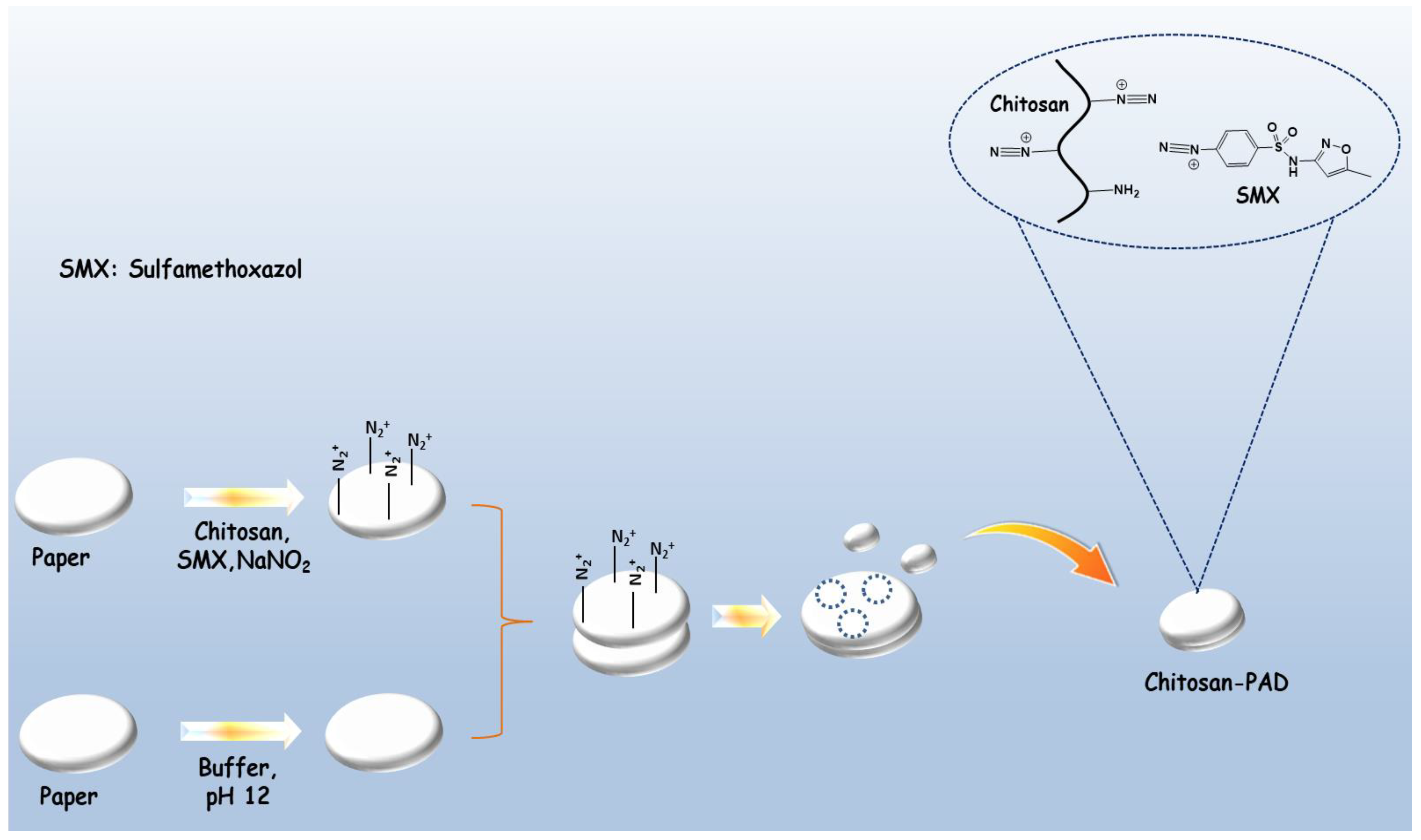
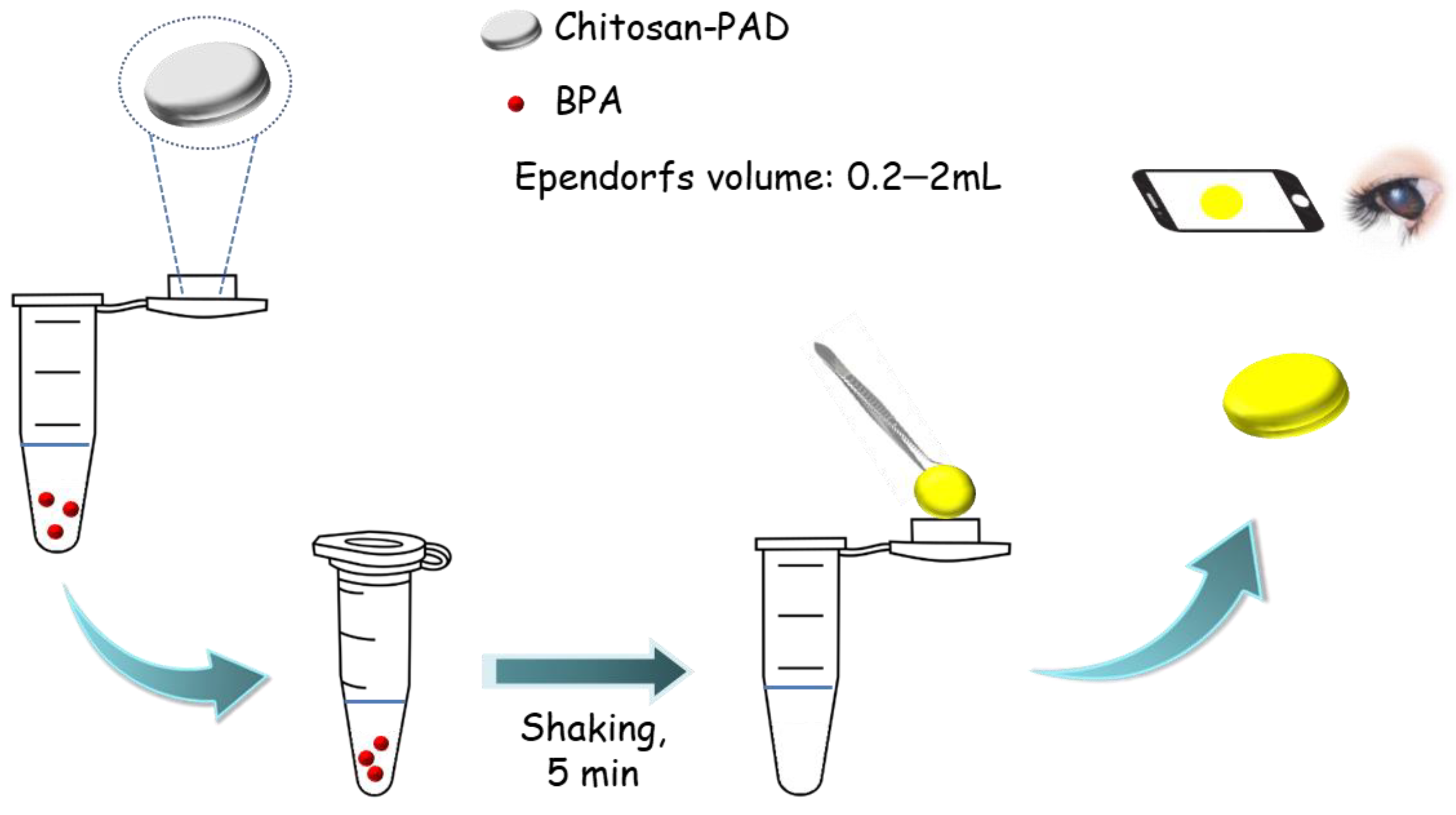

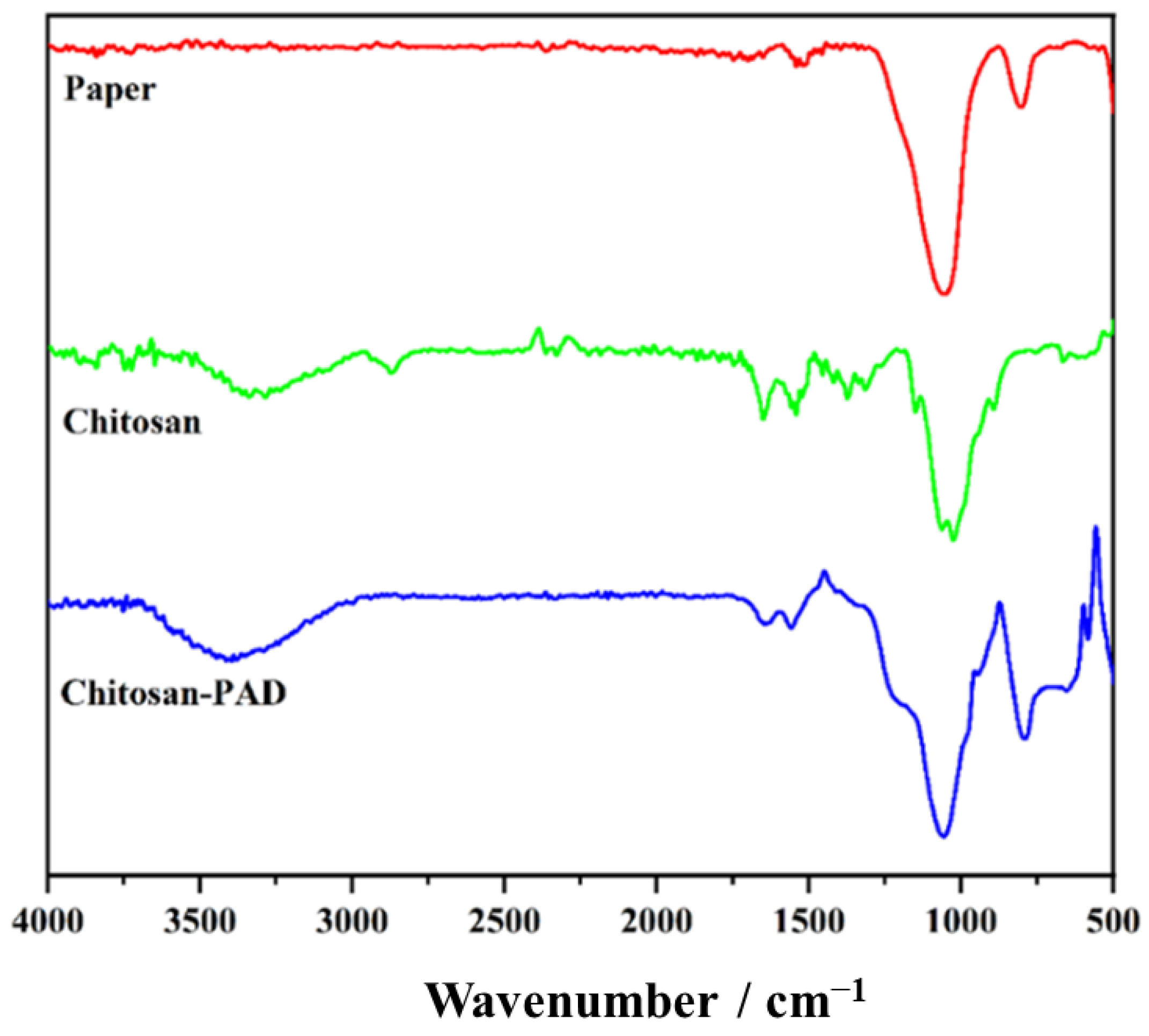

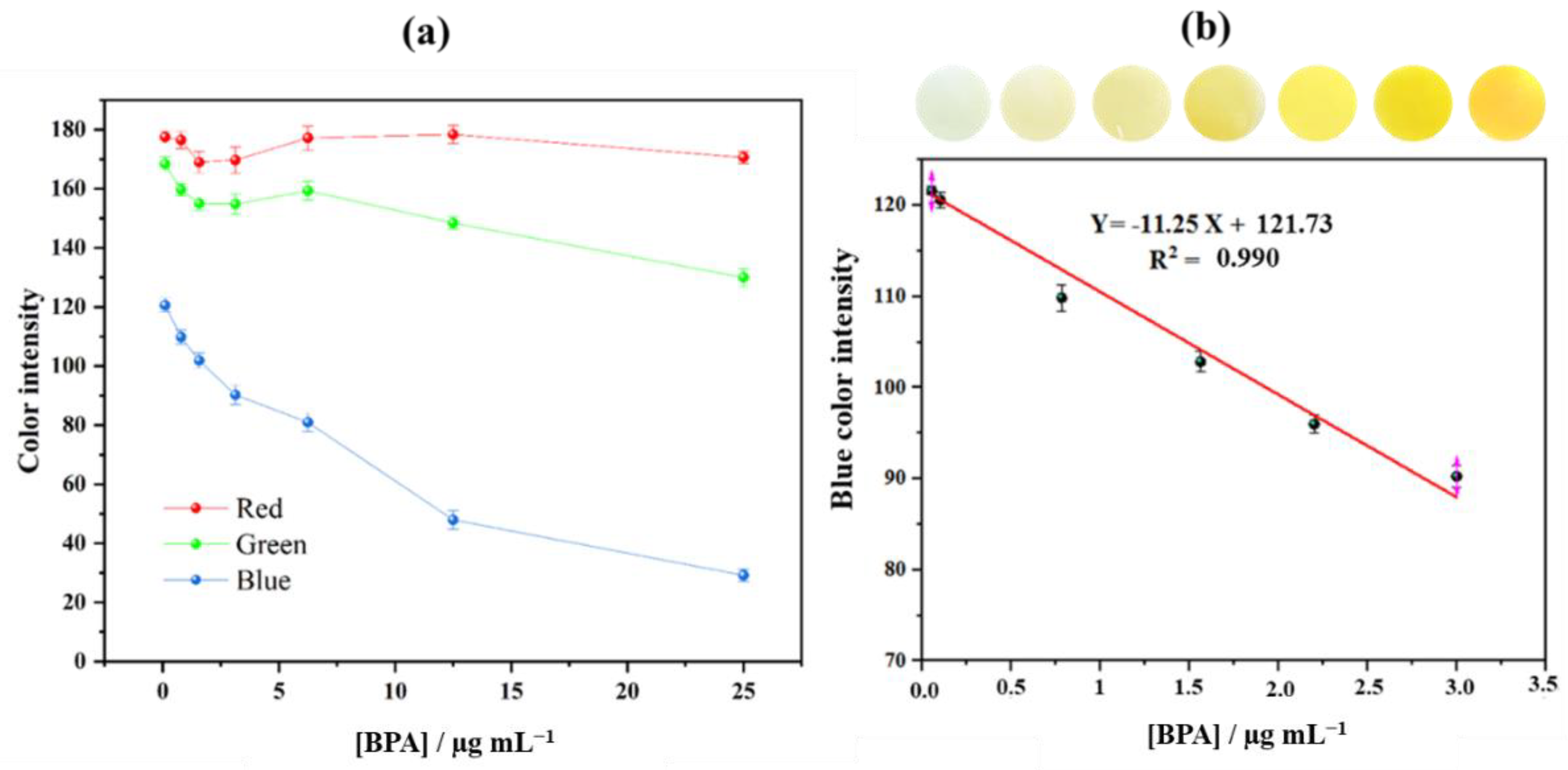
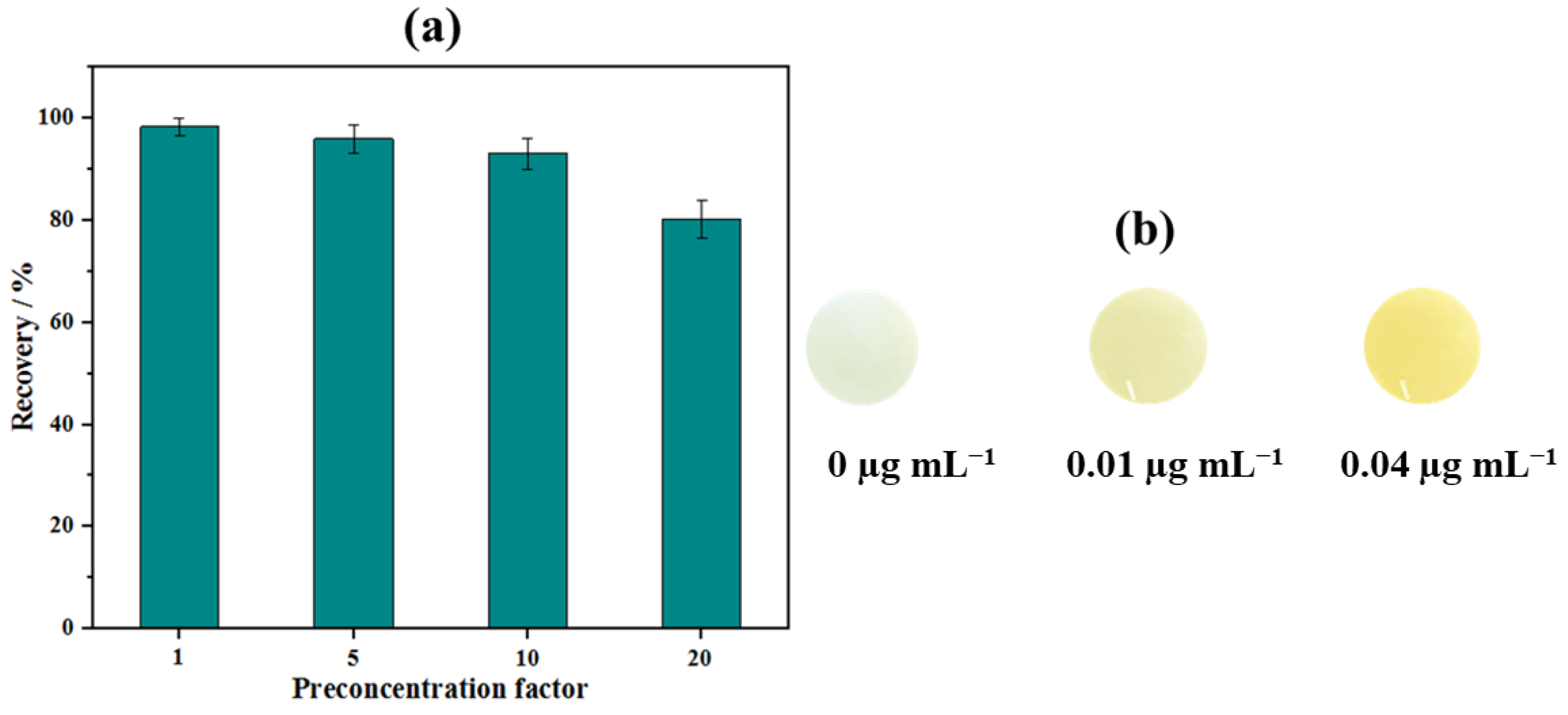
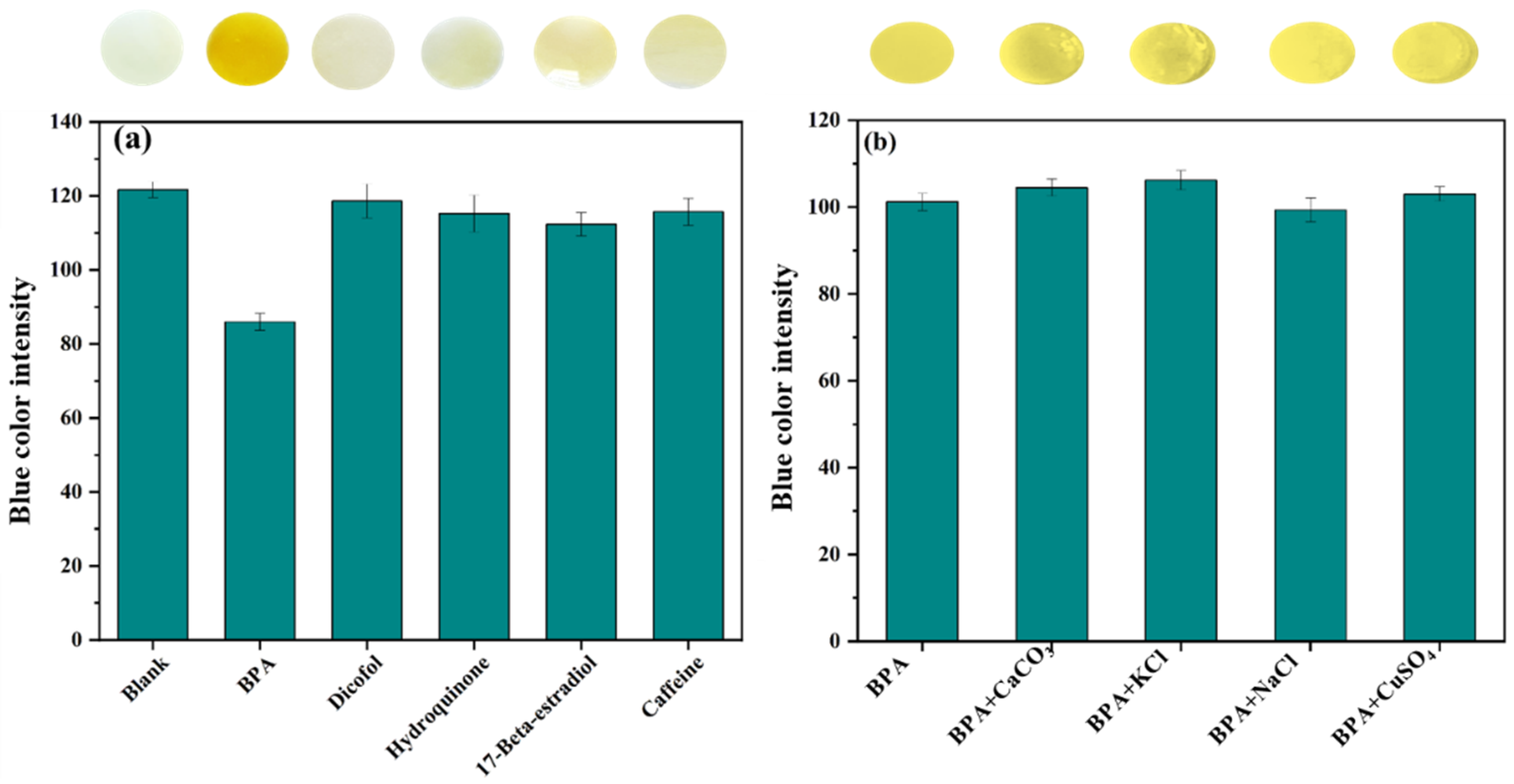
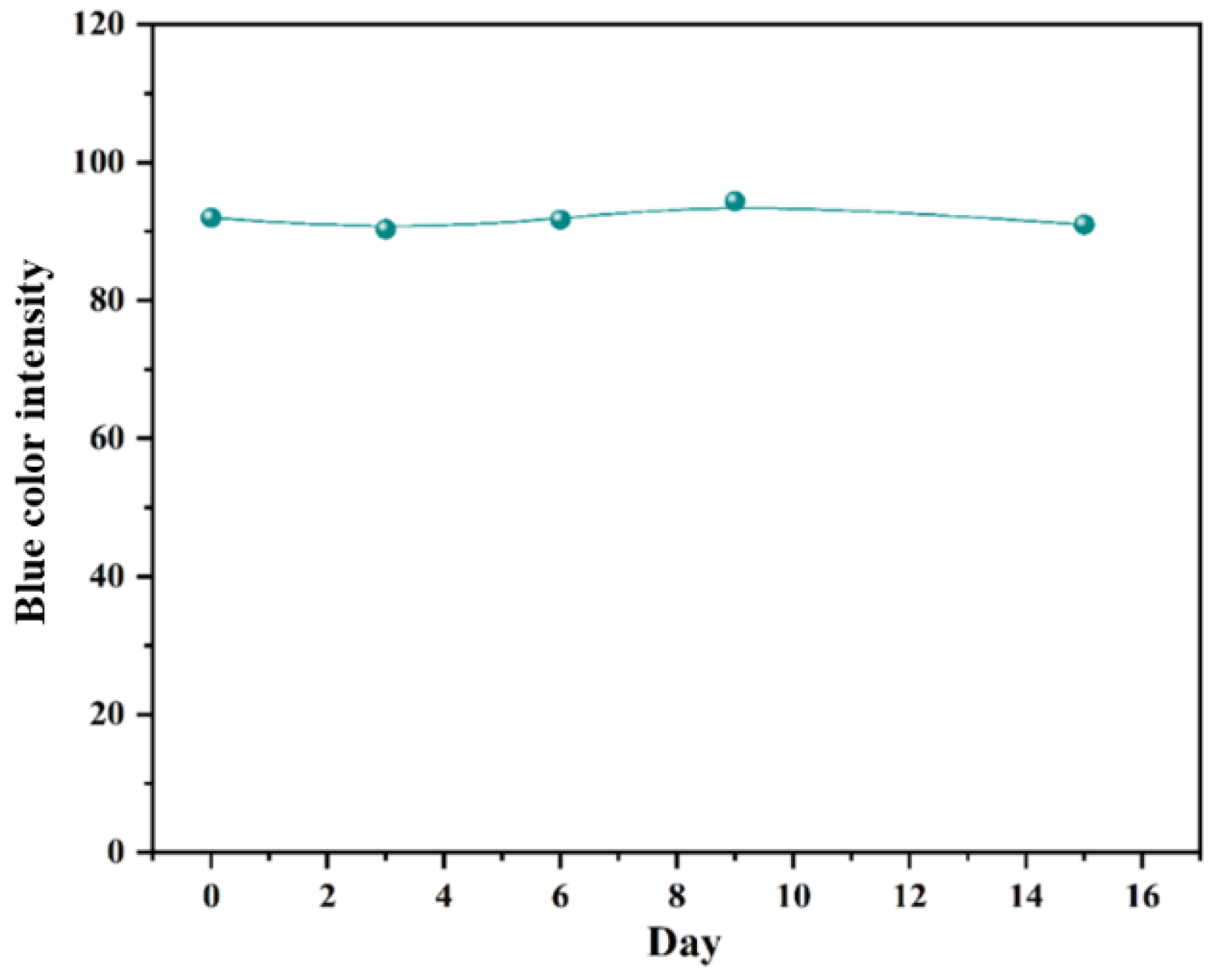
| Added (µg mL−1) | Found (µg mL−1) | Pre-Concentration Factor | Recovery (%) | RSD (%) | |
|---|---|---|---|---|---|
| Tap water | 1.00 | 1.05 | -- | 105 | 1.27 |
| 0.50 | 0.49 | -- | 98 | 2.45 | |
| 0.04 | 0.036 | 10 | 90 | 5.13 | |
| River water | 1 | 0.97 | -- | 97 | 3.00 |
| 0.50 | 0.50 | -- | 100 | 1.78 | |
| 0.04 | 0.038 | 10 | 95 | 4.38 |
Publisher’s Note: MDPI stays neutral with regard to jurisdictional claims in published maps and institutional affiliations. |
© 2022 by the authors. Licensee MDPI, Basel, Switzerland. This article is an open access article distributed under the terms and conditions of the Creative Commons Attribution (CC BY) license (https://creativecommons.org/licenses/by/4.0/).
Share and Cite
Karrat, A.; Amine, A. Paper-Based Analytical Device for One-Step Detection of Bisphenol-A Using Functionalized Chitosan. Chemosensors 2022, 10, 450. https://doi.org/10.3390/chemosensors10110450
Karrat A, Amine A. Paper-Based Analytical Device for One-Step Detection of Bisphenol-A Using Functionalized Chitosan. Chemosensors. 2022; 10(11):450. https://doi.org/10.3390/chemosensors10110450
Chicago/Turabian StyleKarrat, Abdelhafid, and Aziz Amine. 2022. "Paper-Based Analytical Device for One-Step Detection of Bisphenol-A Using Functionalized Chitosan" Chemosensors 10, no. 11: 450. https://doi.org/10.3390/chemosensors10110450
APA StyleKarrat, A., & Amine, A. (2022). Paper-Based Analytical Device for One-Step Detection of Bisphenol-A Using Functionalized Chitosan. Chemosensors, 10(11), 450. https://doi.org/10.3390/chemosensors10110450





